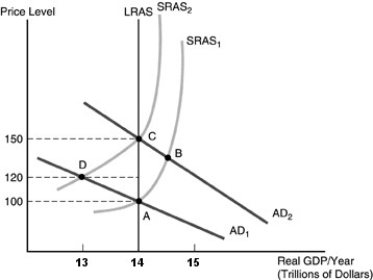
-Refer to the above figure. Suppose the economy is in equilibrium at point A. If the Fed tries to stimulate the economy by undertaking an expansionary monetary policy action and this is NOT expected by the people in the economy, we would expect to see
A) aggregate demand increases, real GDP increases, and the price level increases. In the long run, aggregate supply would increase and the new long-run equilibrium would be point B.
B) aggregate demand increases, real GDP increases, and the price level increases in the short run. In the long run, people realize the real situation, causing the short-run aggregate supply curve to shift up. Real GDP returns to $14 trillion, and the price level increases to 150.
C) aggregate demand increases but people would anticipate this, causing the short-run aggregate supply curve to shift up at the same time, with the new equilibrium of $14 trillion of real GDP and a price level of 100.
D) aggregate supply shifts up as people anticipate the effects of the expansionary monetary system. In the short run, real GDP falls to $13 trillion and the price level rises to 120. In the long run, real GDP returns to $14 trillion, and the price level increases further, to 150.
Correct Answer:
Verified
Q168: The short run aggregate supply (SRAS) curve
Q169: According to the real business cycle theory,
Q170: A reduction in world oil supplies is
Q171: Suppose that the economy is in long-run
Q172: Suppose that the economy is in long-run
Q174: Which of the following statements is consistent
Q175: Under the rational expectations hypothesis, if wages
Q176: Real business cycle theory explains variations in
Q177: Suppose there is an oil supply shock
Q178: According to the rational expectations hypothesis, individuals
Unlock this Answer For Free Now!
View this answer and more for free by performing one of the following actions

Scan the QR code to install the App and get 2 free unlocks

Unlock quizzes for free by uploading documents